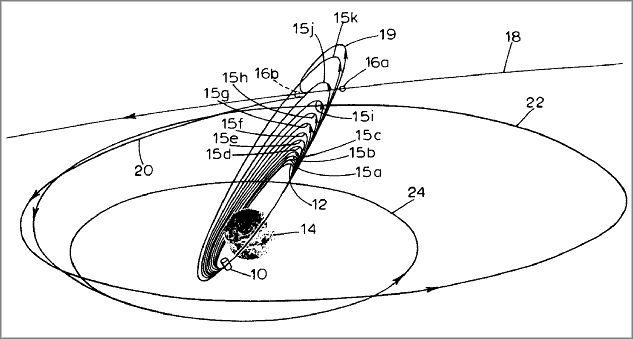Path patent
When discussing the negative side effects of the current patent system, it is useful to recall the story of the satellite AMC-14 , which was lost in March 2008.
Lockheed Martin manufactured the AMC-14 geostationary communications satellite by order of SES Americom, a communications operator, and was to be used on the DISH Network satellite television network. The planned service life was at least 15 years.
The launch of the Proton-M launch vehicle with the satellite took place on March 14, 2008 from Baikonur. Unfortunately, due to a problem with the engine of the Briz-M booster block, the cargo did not reach the planned point. SES Americom and Lockheed Martin tried to raise the satellite to geostationary orbit, using the original maneuver with acceleration through the moon. But this idea had to be abandoned. It turned out thatThe patent for this trajectory belongs to Boeing. As a result, the satellite burned out in the atmosphere.
Illustration from US Patent No. 6116545 " Free return lunar flyby transfer method for geosynchronous satellites ."

The trajectory of movement, which directly follows from the laws of physics, has been patented as an innovative “satellite moving process."
At that time, a lawsuit was already ongoing between SES Americom and Boeing on another issue, on which Boeing was supposed to pay $ 50 million. Boeing said it would give permission to use the above patent if SES Americom waives this claim. Although the value of such a patent is doubtful and it would hardly have passed in court, the management of SES Americom decided to take the opportunity and get insurance payment for a lost satellite. Therefore, the AMC-14 was quickly taken out of orbit and destroyed. Insurance turned out to be more profitable also because after such a difficult maneuver the satellite would have run out of fuel and, in any case, its service life would not have exceeded four of the prescribed fifteen years.
Lockheed Martin manufactured the AMC-14 geostationary communications satellite by order of SES Americom, a communications operator, and was to be used on the DISH Network satellite television network. The planned service life was at least 15 years.
The launch of the Proton-M launch vehicle with the satellite took place on March 14, 2008 from Baikonur. Unfortunately, due to a problem with the engine of the Briz-M booster block, the cargo did not reach the planned point. SES Americom and Lockheed Martin tried to raise the satellite to geostationary orbit, using the original maneuver with acceleration through the moon. But this idea had to be abandoned. It turned out thatThe patent for this trajectory belongs to Boeing. As a result, the satellite burned out in the atmosphere.
Illustration from US Patent No. 6116545 " Free return lunar flyby transfer method for geosynchronous satellites ."

The trajectory of movement, which directly follows from the laws of physics, has been patented as an innovative “satellite moving process."
At that time, a lawsuit was already ongoing between SES Americom and Boeing on another issue, on which Boeing was supposed to pay $ 50 million. Boeing said it would give permission to use the above patent if SES Americom waives this claim. Although the value of such a patent is doubtful and it would hardly have passed in court, the management of SES Americom decided to take the opportunity and get insurance payment for a lost satellite. Therefore, the AMC-14 was quickly taken out of orbit and destroyed. Insurance turned out to be more profitable also because after such a difficult maneuver the satellite would have run out of fuel and, in any case, its service life would not have exceeded four of the prescribed fifteen years.
